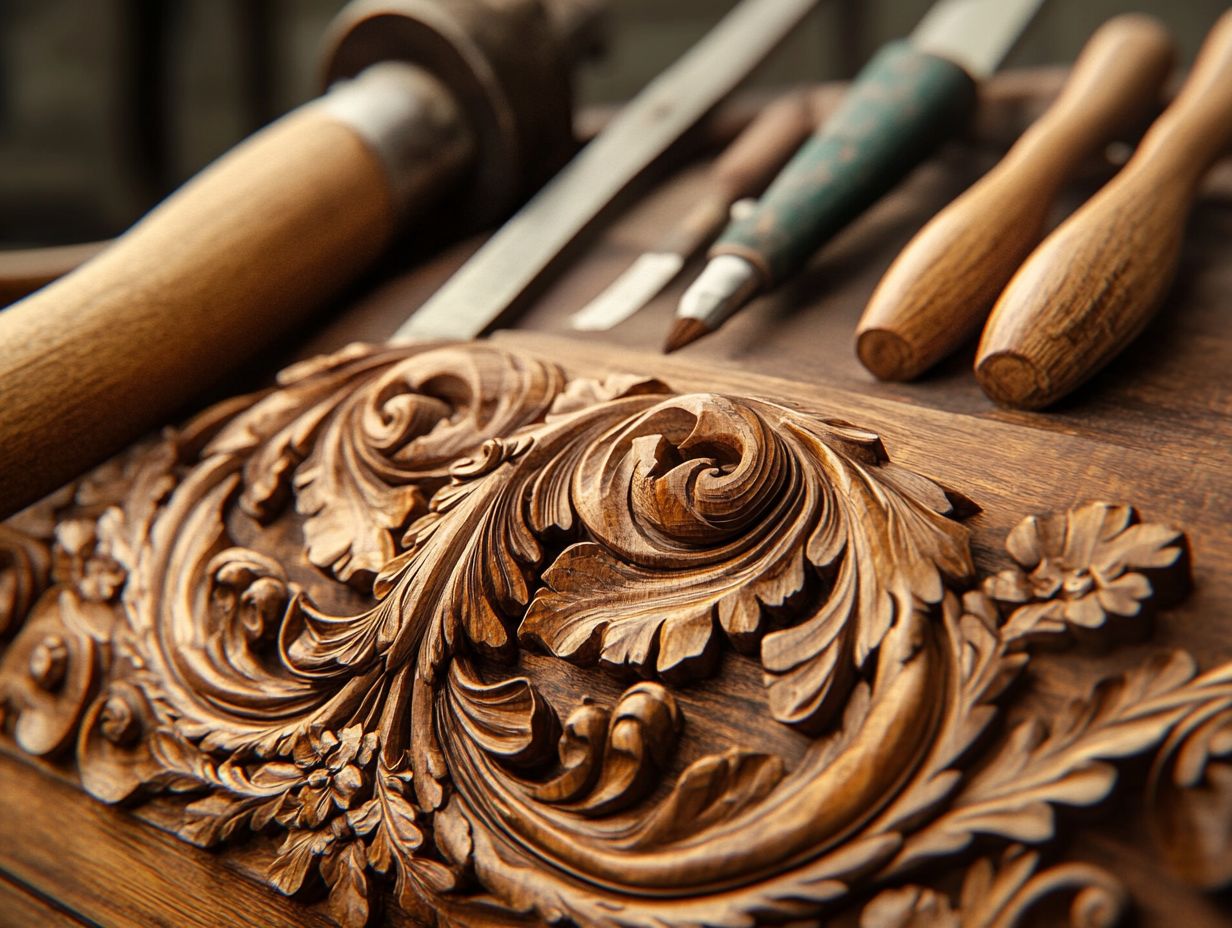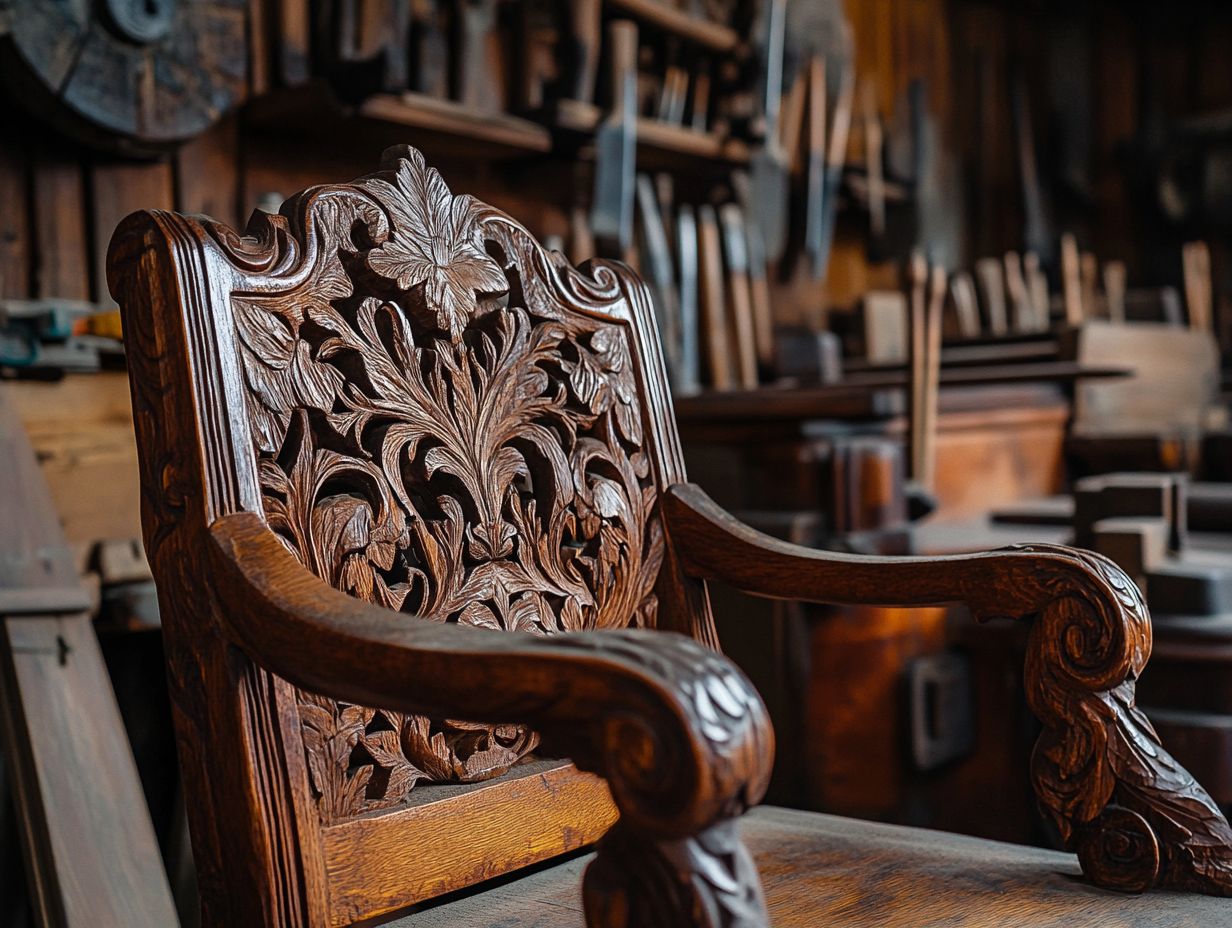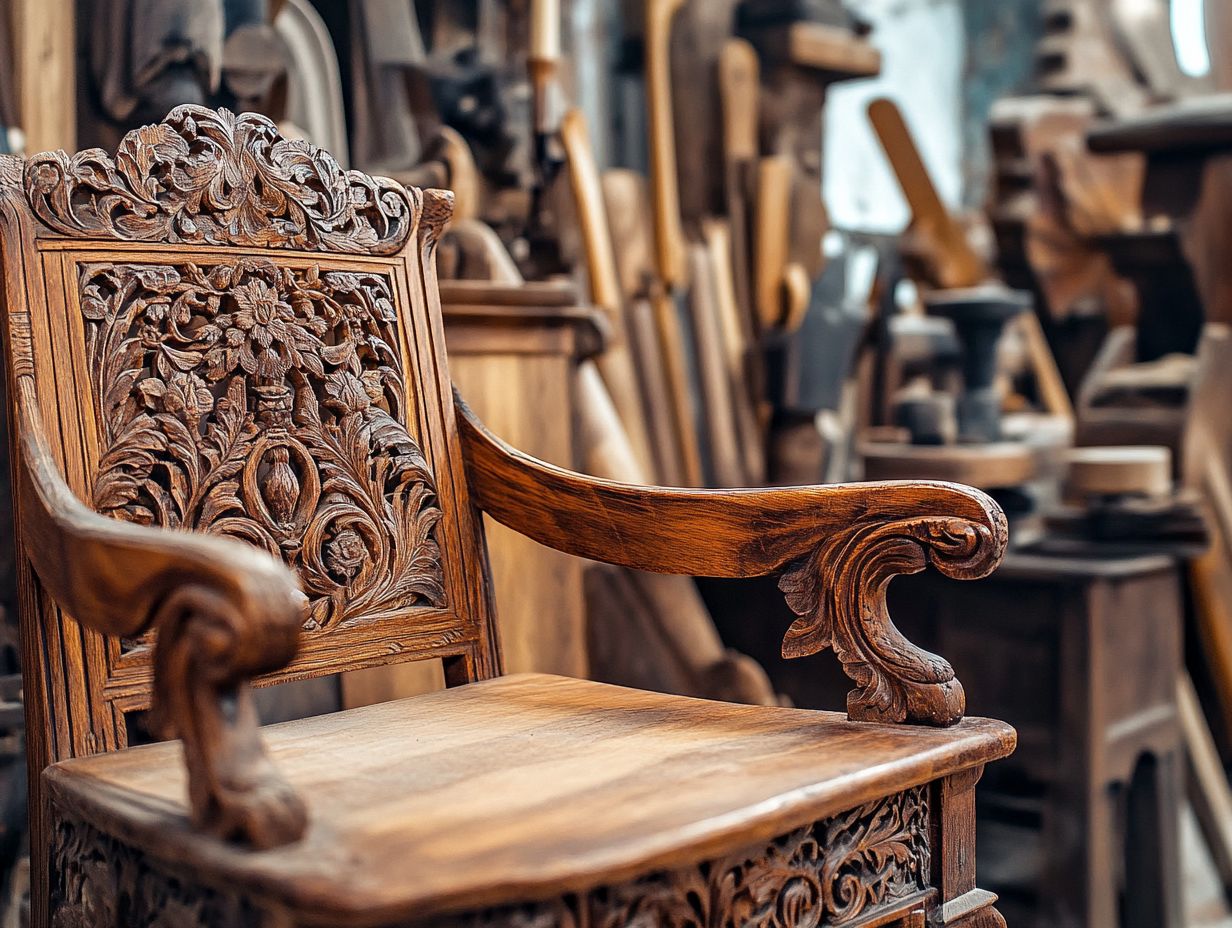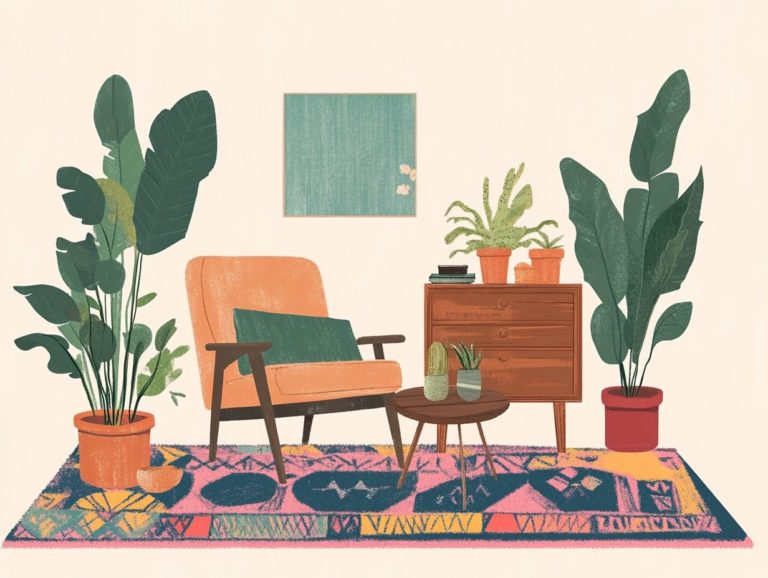Understanding the Craftsmanship of Vintage Furniture
Vintage furniture has a unique charm that spans different times, harmonizing artistry with rich history. It embodies the distinctive appeal that collectors appreciate.
Get ready to explore what truly defines vintage pieces, their timeless appeal, and the pivotal periods, like the Victorian era and Mid-Century Modern, that have influenced their designs.
Discover the amazing materials that make vintage pieces special, along with insights on identifying and assessing these remarkable treasures.
You ll also find essential cleaning tips for maintaining vintage items and integrating them gracefully into contemporary spaces. This will allow your home to reflect a beautiful balance between the past and the present.
Contents
- Key Takeaways:
- The Art of Vintage Furniture
- History of Vintage Furniture
- Materials and Techniques Used
- Identifying and Evaluating Vintage Furniture
- Caring for Vintage Furniture
- Incorporating Vintage Furniture in Modern Spaces
- Frequently Asked Questions
- What is vintage furniture and why is understanding its craftsmanship important?
- What are some common materials used in vintage furniture and how do they contribute to its craftsmanship?
- How can one determine the quality of craftsmanship in vintage furniture?
- What are some characteristics of vintage furniture that make it stand out?
- What are some tips for caring for vintage furniture?
- Is it possible to restore the craftsmanship of damaged vintage furniture?
Key Takeaways:

- Vintage furniture is defined as pieces that are at least 20 years old, and its appeal lies in its unique design, quality materials, and craftsmanship.
- Understanding the history and different styles of vintage furniture can help identify and evaluate its authenticity, condition, and value.
- Proper care and maintenance, as well as incorporating vintage pieces with modern styles, can help preserve and showcase the beauty and craftsmanship of vintage furniture.
The Art of Vintage Furniture
The art of vintage furniture invites you to explore a rich tapestry of styles and historical influences. It reveals unique designs that embody exceptional craftsmanship and timeless elegance.
Each piece whether it features the ornate detailing of the Victorian era or the minimalist aesthetics of Mid-Century Modern tells a story steeped in history. They frequently showcase luxurious fabrics that speak to their origins.
Vintage furniture not only highlights a variety of styles but also evokes a sense of nostalgia. It captures a unique charm and appreciation for history that has stood the test of time.
Grasping these historical design elements is essential if you aim to curate an eclectic mix of vintage treasures, including retro fusion with modern reproductions, within contemporary spaces.
Defining Vintage Furniture
Defining vintage furniture means recognizing pieces that are not just old but also carry unique aesthetics, historical significance, and timeless character. These qualities set them apart from modern reproductions.
These items typically originate from a specific era, often spanning 20 to 100 years ago. They showcase design styles that reflect the cultural and artistic movements of their time, such as Art Deco and Scandinavian design.
Unlike antiques, which are generally considered to be over 100 years old, vintage pieces are celebrated for their craftsmanship. They encapsulate the spirit of their period, often showcasing intricate carvings and ornate ornamentation.
The allure of vintage furniture lies in its character, often marked by distinctive natural materials, colors, and forms. These evoke a bygone era and a nostalgic appeal.
These pieces do more than serve functional purposes; they infuse contemporary spaces with a sense of nostalgia, individuality, and the timeless appeal that modern furnishings sometimes struggle to achieve.
The Appeal of Vintage Pieces
The allure of vintage pieces captivates you with their nostalgic charm. They stir memories and emotions that weave a connection to the past through the storytelling woven into their craftsmanship and unique designs.
These extraordinary artifacts serve as a tangible bridge to bygone eras. They often evoke reflections on significant moments or cherished loved ones, enriching your appreciation for history.
The craftsmanship behind vintage items displays a quality that frequently outshines modern manufacturing. This is often characterized by intricate craftsmanship techniques that express genuine artistry.
Take, for instance, the enduring appeal of Mid-Century Modern furniture. It is celebrated for its minimalist lines, functional beauty, and its representation of sustainable practices.
Similarly, vintage jewelry, like Art Deco rings adorned with intricate designs, offers a unique allure that speaks volumes about the artistry of a different time. This allows you to cherish their distinctiveness, history, and authentic vintage characteristics.
History of Vintage Furniture
The history of vintage furniture unfolds as a captivating journey through time, revealing an array of styles, historical influences, and significant furniture designs that have shaped furniture design across different eras.
Picture the ornate elegance of the Victorian period, the striking bold patterns of Art Deco, and the refined simplicity that defines Mid-Century Modern aesthetics. Consider the impact of the Industrial Revolution on design as well. Each era tells its own unique story, reflecting the tastes, cultural movements, and historical context of its time, which includes influences from styles like Gothic Revival and Rococo Revival.
Key Styles That Shaped Vintage Furniture

Influential periods in furniture history like the Victorian era, Art Deco, and Mid-Century Modern capture well the cultural and social contexts of their times. They showcase the craftsmanship quality that defines each period.
These eras go beyond looks; they are intricately linked with economic conditions, technological advancements, and evolving societal values. These factors influence everything from Scandinavian design to the work of designers like Charles Eames and Arne Jacobsen.
Take the Victorian era, for example. It featured fancy decorations and detailed designs, coupled with an unwavering dedication to craftsmanship. This often included intricate woodwork and sumptuous fabrics that spoke volumes of opulence.
In contrast, Art Deco burst onto the scene in the early 20th century, defined by bold geometric shapes, vibrant colors, and a daring use of industrial materials like chrome. This style vividly reflects a fascination with modernity, glamour, and the evolving design elements that captivated a generation.
Then there s Mid-Century Modern, championed by design icons such as Charles Eames, George Nelson, and the innovative approaches of designers like Arne Jacobsen. This movement revolutionized the field with its emphasis on functional simplicity, organic forms, and innovative material usage. It captured the post-war optimism and a desire for a more accessible approach to design, alongside sustainable practices.
Materials and Techniques Used
The materials and techniques employed in vintage furniture construction are essential to its timeless allure. Vintage furniture often utilizes reclaimed wood and other natural materials to enhance sustainability. There s a strong emphasis on natural materials and craftsmanship methods that elevate both the aesthetic appeal and durability of each piece, making a compelling case for vintage shopping.
Quality Materials and Construction Methods
Quality materials and construction methods significantly influence the longevity and vintage appeal of your furniture pieces, especially regarding furniture restoration and conservation. They showcase the craftsmanship details and intricate techniques that reflect true skill and dedication.
When it comes to vintage furniture, choosing natural resources like hardwood, leather, and textiles not only enhances aesthetic charm but also aligns with a sustainable approach that prioritizes environmental responsibility and authentic vintage craftsmanship.
Artisans often utilize time-honored techniques, carefully selecting premium materials that age gracefully and develop unique colors and textures over time, thus ensuring the timeless character of each piece.
This meticulous attention to detail, whether it’s in a strong type of joint used in construction, hand-carved designs, or ornate carvings, highlights the superior construction that sets vintage pieces apart from contemporary mass-produced alternatives. For those curious about what makes vintage furniture unique, this distinction ultimately elevates their value, desirability, and connection to the historical context of design.
Identifying and Evaluating Vintage Furniture
Identifying and evaluating vintage furniture demands your keen eye for unique characteristics, coupled with a solid understanding of vintage styles and how to assess both condition and value.
This knowledge is essential for collectors and enthusiasts who seek to appreciate and invest in timeless pieces while fostering a growing interest in vintage shopping.
Key Characteristics to Look For
When identifying vintage furniture, pay attention to key characteristics such as craftsmanship quality, unique designs, and historical influences. These serve as indicators of authenticity, value, and the storytelling pieces behind each item.
Look for intricate joinery techniques, like dovetail or mortise-and-tenon joints (strong joint types used in quality furniture). These reflect superior craftsmanship and promise longevity, contributing to the vintage appeal of the piece. For more insights, check out what to look for when buying vintage furniture.
Unique design elements think tapered legs, sculptural forms, or ornate carvings signal the artistry and historical context involved in creating the piece. The choice of materials also plays a vital role; solid woods like walnut, mahogany, or teak are synonymous with durability, timeless beauty, and sustainable practices. To delve deeper into these aspects, consider exploring understanding the value of vintage furniture.
Styles such as Mid-Century Modern, known for its clean lines and functional forms, or Art Deco, celebrated for bold colors, geometric patterns, and luxurious finishes, exemplify the rich attributes that define vintage furniture. To ensure you’re choosing the best pieces, it’s essential to know what to look for in vintage furniture quality.
Assessing Condition and Value

Assessing the condition and value of vintage furniture requires evaluating several key factors, including wear, restoration needs, and historical significance. All these factors shape its appeal to collectors and their interest in antique collectibles.
Your evaluation process should begin with a careful visual check. Look for noticeable scratches, dents, or discoloration that might hint at age or neglect. Consider the craftsmanship techniques that define its worth.
Next, checking for structural integrity is essential. Wobbly legs, loose joints, or signs of water damage can significantly impact the piece’s market value and its perceived vintage appeal.
Understanding the original materials and craftsmanship is also crucial, as these elements influence potential restoration needs and the overall historical context of the piece. Delving into the provenance of the piece enhances its historical context, making it even more desirable for collectors and enthusiasts of vintage shopping.
By conducting these assessments diligently, you can establish a more accurate valuation that truly reflects both the piece’s condition and its collectible merit.
Caring for Vintage Furniture
Caring for vintage furniture is crucial for preserving its unique charm and craftsmanship. Keep your vintage treasure looking stunning by adopting specific cleaning tips and maintenance practices tailored to these exquisite pieces.
Proper Maintenance and Preservation
Proper maintenance and preservation techniques are essential for sustaining the integrity and craftsmanship of your vintage furniture. This ensures these treasured pieces retain their original beauty and functionality.
By taking a proactive approach to care, you can protect the delicate materials and finishes typically found in older items. Regular dusting with a soft, lint-free cloth prevents the accumulation of grime that can dull surfaces and cause scratches.
Implementing moisture control strategies, like placing silica gel packets in storage areas, can significantly reduce the risk of mold and warping that often plagues wooden pieces. Applying suitable wax or oil treatments nourishes the wood and maintains its luster, ultimately extending its lifespan while preserving its vintage charm.
Incorporating Vintage Furniture in Modern Spaces
Incorporating vintage furniture into modern spaces enables you to create a captivating retro fusion. This blend of unique designs and contemporary aesthetics results in an eclectic mix that exudes timeless character.
Embrace the charm of the past while enhancing your current decor. Watch as each piece tells its own story within your stylish environment. Act now to protect your investment from wear and tear!
Start exploring vintage furniture today to find your unique piece!
Tips for Mixing and Matching Styles
Mixing and matching vintage and modern styles is an art that requires understanding furniture designs and developing an eye for eclectic aesthetics. Get ready to create a stunning, cohesive look that reflects your unique style!
To achieve this delightful blend, start by identifying a color palette that harmonizes both eras. This will allow key pieces to stand out beautifully without clashing. Consider anchoring your design with larger items perhaps a sleek modern sofa paired with a charming vintage coffee table. This creates a conversation-worthy focal point that draws the eye.
When hunting for vintage treasures, explore local thrift stores, flea markets, or online platforms. Don t miss out on hidden treasures waiting for you! Embrace a little repair work; refurbished items can add character and charm to your space.
Elevate your rooms further by thoughtfully selecting accessories. Combine sleek, contemporary lighting with retro decor. This approach unifies your style choices and tells a unique story that reflects your personal expression.
Frequently Asked Questions

What is vintage furniture and why is understanding its craftsmanship important?
Vintage furniture refers to pieces that are at least 20 years old and are considered to be of high quality and value due to their age and historical significance. Understanding the craftsmanship of vintage furniture is important because it allows us to appreciate and preserve these pieces of history.
What are some common materials used in vintage furniture and how do they contribute to its craftsmanship?
Common materials used in vintage furniture include solid wood, veneer, metal, and upholstery fabrics. Veneer is a thin layer of wood that adds beauty and durability. These materials are carefully chosen for their durability, aesthetics, and functionality, and their combination and execution contribute to the overall craftsmanship of the piece.
How can one determine the quality of craftsmanship in vintage furniture?
One way to determine the quality of craftsmanship in vintage furniture is to look at the construction techniques used. High-quality pieces will have precise and sturdy joints, such as dovetails and mortise and tenon, showing attention to detail in their execution.
What are some characteristics of vintage furniture that make it stand out?
Vintage furniture often has unique and intricate designs, hand-carved details, and high-quality materials and finishes. These characteristics reflect the time and skill put into crafting each piece, making it stand out and adding to its value and appeal.
What are some tips for caring for vintage furniture?
- Handle with care.
- Avoid using harsh chemicals or abrasive materials.
- Regularly dust and polish the piece.
- Keep vintage furniture away from direct sunlight and extreme temperatures.
Is it possible to restore the craftsmanship of damaged vintage furniture?
Yes, it is possible to restore the craftsmanship of damaged vintage furniture. However, it is important to seek professional help and not attempt to fix it yourself, as improper restoration can decrease its value. A skilled restorer can carefully repair and preserve the original craftsmanship of the piece.
Start your vintage journey today and uncover pieces that tell your story!





